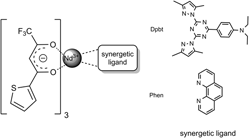Article contents
NIR luminescence of a visible-light-sensitized neodymium complex with large experimental fluorescence branching ratio for 4F3/2→4I11/2 in PMMA
Published online by Cambridge University Press: 13 May 2011
Abstract

In this work, a visible-light-sensitized neodymium complex with 2-(N,N-diethylanilin-4-yl)-4,6-bis(3,5-dimethylpyrazol-1-yl)-1,3,5-triazine (Dpbt) as a synergetic ligand is synthesized and incorporated into poly(methyl methacrylate) (PMMA). Absorption and luminescent spectra of Nd(TTA)3Dpbt (TTA = thenoyltrifluoroacetonate) in PMMA are measured and compared with common complex Nd(TTA)3Phen (Phen = 1,10-phenanthroline). As a result, Nd(TTA)3Dpbt has relatively high luminescent intensity and wide excited spectral range, attributed to the sensitization of the ligand Dpbt. Judd–Ofelt analysis is used, and Judd–Ofelt parameters are calculated (Ω2 = 33.72 × 10−20 cm2, Ω4 = 11.52 × 10−20 cm2, and Ω6 = 6.81 × 10−20 cm2). The radiative properties are predicted and compared with other different Nd complexes. The stimulated emission cross-section of 4F3/2→4I11/2 transition is 3.02 × 10−20 cm2 and the estimated lifetime is 506 μs using the Judd–Ofelt parameters. Experimental fluorescence branching ratio of this transition is quite high for Nd ions. The radiative properties’ investigation for 4F3/2→4I11/2 transition indicates that it is possible to be a laser transition.
Keywords
- Type
- Articles
- Information
- Copyright
- Copyright © Materials Research Society 2011
References
REFERENCES
- 8
- Cited by


